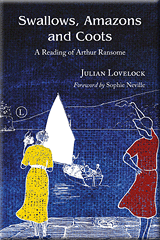The world of the Swallows and Amazons, so permanently close to the hearts and the cartography of those in the Lake District, is likely to come under further scrutiny this year, the 50th anniversary of the death of Arthur Ransome, master storyteller.
We’ve seen two film versions and a stage musical, but return time and again to the treasure islanded in the stories, set both in the Lakes and – with the young heroes of the Coot Club and their friends – in the Norfolk Broads.
Now comes the first critical book devoted wholly to the series of stories, a scholarly work in which enthusiast Julian Lovelock delves beyond the narratives and the landscapes to examine the text and the context of Ransome’s work.

Lovelock argues that to be properly appreciated today, the Swallows and Amazons novels must be read as products of their era, “not as dead period pieces, but as exciting and relevant adventures which propound a strong personal morality and a love of nature and outdoor life, turning to advantage their setting in an increasingly distant past”.
Certainly Ransome was one of the last Romantics, conscious that the countryside he describes so lovingly and in such intricate detail, was under threat; as too was the age of innocence portrayed in his characters. And there’s much scrutiny here of how that world was transfigured through the games that the children played, and through their imaginations.
There’s examination, too, of the complex gender stereotypes, of Nancy Blackett as the ultimate tomboy, but Titty too complex to be labelled as the young sister, thanks to the power of her imagination. Susan, on the other hand, is “nothing less than a domestic goddess” says Lovelock, organising the camps, cooking wholesome food, insisting on teeth being cleaned, and worrying about bedtimes. So if she is at times “an almost comic parody of a wife and mother of the period” is it any wonder that few young readers would want to BE Susan when playing their own games?
Much is made of the young adventurers as imperialist colonisers, particularly in the first book where they discover Wild Cat Island. (But let’s not spend too much time seeking out the locations, says Lovelock. However realistic that world appears “too much can be made of the possible connections between real places and people and their fictional counterparts”.)
This is fascinating scrutiny and an account which will be enjoyed by Ransome fans as well as scholars, but one point is particularly poignant now, as we seem to be heading into a dark age politically, perhaps more so than at any time since the end of the Second World War. Lovelock writes of the optimism of Swallowdale, a story full of things that go wrong – the wreck of the Swallow, the loss of Roger in the fog – where there is, nevertheless a sense that everything will be all right in the end, as it is.
This sense of optimism runs through all the books, and might well be one of the reasons for their longevity. Just as readers living in a depressed economy and the stirrings of Hitler’s Germany found happy escapism in the “gentle tales of camping and sailing in an untroubled world”, might we not all be glad of that chance to escape from a world reality which has strong elements of nightmare?
There is, after all, only one universal rule for survival that we need to worry about here: “Better drowned than duffers. If not duffers won’t drown.”
Swallows, Amazons and Coots: A Reading of Arthur Ransome (Lutterworth Press £20)) by Julian Lovelock
Pingback: Swallows, Amazons and the need for escapism